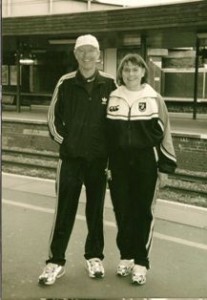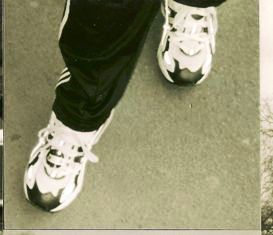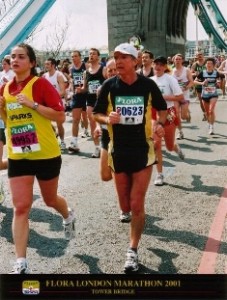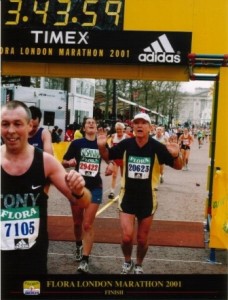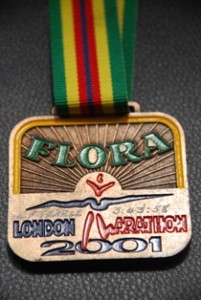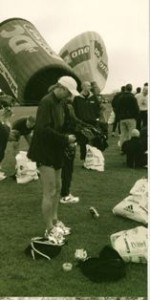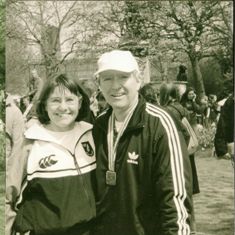By Ewart Tearle
April 2012.
I’ve been a photographer for many years – at times semi-professionally, several times published, but mostly as a keen amateur. You’d think that going round snapping buildings, sights, scenes and landscapes would be a pretty innocuous occupation in your spare time; but not so. In 2006 I ran foul of the City of London Police one lunch hour while I was working for Sainsbury’s in their Holborn office.
I was team leader of a group of members of the Sainsbury’s IT Service Desk and we had just moved the entire IT division from an office in Union St, Southwark, to the new Sainsbury’s Head Office at 33 Holborn, London City. I volunteered to document the area we had moved to and to write weekly articles for publication to the IT division on our intranet under the generic title “Our Neighbourhood.”
It involved exploring an area around Holborn Circus that was big enough for me to walk anywhere I wanted to, so long as I was back at my desk within the hour. I could explore almost the entire City of London; lunch in one hand, camera in the other. Many of those articles are reproduced in the London Stories section of this site, but one particular story was held back because suddenly it was very controversial. It started off innocuously enough as a story about the history of the press in Fleet Street.
You can walk to Fleet Street from Holborn Circus in about ten minutes, by a number of different routes, so I spent many months walking up and down one of London’s most famous streets and visiting many of its historical sites, including St Mary Fleet, the Home Church for London’s journalists. One of the things I noticed early on was that buildings which had large clocks overhanging the footpath anywhere in the area of Fleet Street, were probably once press offices, or publishing houses, even if they were no longer used for that purpose.
I think it was a Victorian idea of public service; the trains ran on a timetable and it was necessary for everyone to know the time. Very few people could afford a watch so these street clocks helped people keep track of the time, but whilst they reinforced the valuable contribution of the newspapers to the public good, they also reminded the population that time was flying by and there were deadlines to meet. Cleanliness was next to godliness, and punctuality was a virtue. I kept an eye out for clocks.
At lunchtime on 18 Sep 2006, I took a shortcut from Fleet St via Furnival St to Holborn, and I saw just such a clock on a handsome brick building with JC on the street-level window and lots of little hooped windows on the top storey. Some yellow cones sat on the road outside. I surmised that the road had been blocked off for the visit of an important person at some time during the day. I stood on the corner opposite the building, well clear of the cones, and took some photographs of the building and its clock.
There was a yell, answered by another yell and then stamping feet. As I lowered my camera three huge men in greatcoats and a shorter man in a high-vis jacket surrounded me. “What are you doing?” shouted the biggest of them, glaring down at me.
“Photographing the clock,” I replied and pointed to it. The high-vis turned and looked around, but six eyes stayed locked on me.
“You can’t photograph that building,” said the one directly in front of me, his brown eyes glowering in anger, his nose close to mine. His was a leather greatcoat and it was heavy with anger and threat.
“I’m in a public place,” I said, “and so is the building.”
“It’s a private building and you can’t photograph it,” said the second man, his bald head glistening in the midday sunshine.
“I can photograph any of the buildings around here, and I have, and no-one’s come and told me to stop, so what’s the problem?” I asked.
“You can photograph all of them if you want to, but you can’t photograph this one.”
I was never going to change their minds. I gave up. “Ok, I’ll get back to work, then.”
“We’ve called the police, you stay here until they arrive.”
“You can call whomsoever you like,” I snapped, “but you are just a security man, and an ordinary citizen, the same as me. I’m in a public place and you cannot prevent me from leaving.” I was shaking with apprehension. I took a step towards the gap between the gathered men. Incredibly, they moved aside. I walked towards Holborn without a backward glance.
“WOOOO-Wer!”
I looked around. It was a police car. Had that security crew really called the police? And had the police responded? I gathered the noise of the siren was directed towards me. I stopped and waited for whatever happened next in these situations. The car stopped some yards away and as its doors opened, two officers in full police uniform alighted from the front of the car and walked towards me. At least the car’s lights weren’t flashing.
“Your name?”
I told them
“Have you got any identity?”
In order for me to get back into the Sainsbury’s building I had to swipe an authorisation card at the barrier. Every lunch hour long queues would form as people alighted from the lifts, eased their card to the end of its lanyard and ducked their heads to bring their cards into contact with the reader. My card had my name and photo on it; I suppose I was lucky because normally I don’t carry ID on me. I took the lanyard from around my neck, slid the card out of my top shirt pocket and offered it to the waiting officer.
The shorter, thick-set officer reached out and took the card. He looked at me and at the card several times. “You work for Sainsbury’s? Where?”
“On the corner of Holborn Circus, opposite St Andrews Church,” I said carefully. “The Head Office.”
“Ok,” he said and handed me the card.
As I put it back into my pocket, I took out my diary and said, “Now that you know my name, I would like to know who I am talking to. Are those numbers on your epaulettes your police identities?” The other officer, taller, slimmer, more wary, looked at me carefully and nodded. I wrote down their numbers, and he told me their names.
“I understand you had an altercation back there,” said the shorter officer, glancing back over his shoulder, to indicate where the car had come from.
“I wouldn’t call it an altercation,” I said. “I was photographing the clock on the corner building and these guys surrounded me and demanded I stop. I pointed out I was in a public place and so was the building, and they wanted to hold me there until the police arrived. I told them I was leaving because I hadn’t done anything wrong, and I left. No-one touched me, and I didn’t touch them.”
“That’s true,” said the shorter officer, taking over. He produced a notepad from an inside pocket of his uniform and flipped it open. “I need to fill out an incident report,” he said. “Name? Address? Date of birth? Place of birth?” He wrote them all down.
“What incident?” I asked, “Why are you filling out a form, what have I done wrong?”
“We’ve spoken to you for more than two minutes, so we are required to fill out this form under the Terrorism Act.”
“Am I a terrorist?” I was aghast.
“No, no!” he remonstrated, smiling.
“Am I under arrest?”
“No, not at the moment.”
“What’s going to happen to this form?”
“It’s just filed in a drawer in the Snow Hill Police Station. If nothing happens in the next few weeks, it’s not recorded any further. It doesn’t get computerised, nothing like that.”
“So what’s this all about?”
“Why did you photograph the building?” I told him about the stories I was writing for the Help Desk and this particular story about Fleet Street and the clocks. I offered to give him a copy of the stories I had already written and published.
“Do you know what the building is?” he asked pointedly. I must have looked blank, because I hadn’t had time to find out. “It’s the Jewish Chronicle. Didn’t you see the security signs?” I thought for a second – so the clock said exactly what I thought it said; this was a building used by the press.
“I saw the green signs and the yellow cones, but I was well outside the area – I was on the opposite side of the road, on the footpath, so I was outside the security area, surely.”
“It isn’t just what’s inside the signs,” he said “This whole area is a security zone.” He waved his arm airily over the entire street and down the hill towards the Holborn Viaduct.
“Why?”
“Because we don’t want people blowing up the Jewish Chronicle. You must be aware of the situation in Palestine.” I thought, the Middle East is along way from London.
“Hang on a minute,” I said. “You don’t want me to photograph the Jewish Chronicle because people might find out where it is?” He nodded. I pointed to my left, “About two hundred metres that way, across Holborn, is the London Islamic Centre, right next to St Albans Church, and on High Holborn, about half a mile from here, is the Arab Press House, I have photographed both of those places, including on a Friday when they are very busy and no-one has objected in any way.”
“Well,” he said slowly, “No-one is going to blow them up, are they?”
“It doesn’t seem possible that the Islamic Centre is unaware of the location of the Jewish Chronicle so close to them. How could a photograph of mine possibly be a security risk to the Chronicle?”
His face clamped shut. He was finished with discussion. “I’m pleased you’re not going to photograph it again.” he said, steel in his voice. He tore off the pink copy of his notes and handed it to me. “One of my colleagues will be visiting you in Sainsbury’s, probably tomorrow.” The two officers turned back to their quietly idling vehicle.
I didn’t wait to see the car drive off. As I walked toward Holborn I examined the slip. They had described me as 6’0 tall, medium build, short brown hair, white shirt, black trousers, black shoes. PNC ID Code IC1, Ethnic W1. The comments were worrying:
DETAILS:
“Seen taking photos in area of Jewish Chronical.”
AUTHORITY:
“Allegation made was seen photographing Chronical Refused to stop when questioned. No search. Legitimate photographer.”
The last two words were an intense relief, but “Refused to stop when questioned” seemed odd. I stopped for questioning by the police. Did they mean I was supposed to stop if I was questioned by the security detail? Actually, I did stop and I did answer their questions. Or was I required to wait with the men for the police to arrive? I thoughtfully folded the slip and finished the walk back to Sainsbury’s. How on earth are you supposed to know where a “security area” is when such places seem to be made up on the spur of the moment? And if you do know a “security zone” is in force, what are you not allowed to do while you are within it?
I photograph interesting things in unusual places: in Fleet St alone I had photographed the Mary Queen of Scots statue, King Lud and his sons, Sweeney Todd’s salon, Queen Elizabeth I, the Romanian Orthodox Church altar in the Church of St Dunstan in the West, the beautiful Art Deco clock on 141 Fleet St, even the gin palace entrance to Lloyd’s Bank, but when I photographed the clock on the Jewish Chronicle – suddenly I’m being questioned under the Terrorism Act. Not one of those signs in front of the Chronicle building said “No Photographs.” My pink slip said I was questioned under Section 44 (2), which I later found out were the stop and search powers. It was not dated. I put the slip into my desk diary, printed four of my “Our Neighbourhood” articles that I had written for the intranet, and put them in an envelope.
True to his word, two more officers did turn up at Sainsbury’s Head Office the following afternoon. I received a call from Reception.
“There are two police officers from the Met here to see you. Can you come to Reception, please?”
I rang HR and told them briefly about my adventure in Furnival St the previous day. I asked them if someone would like to accompany me.
“Ring us back if you get arrested, and we’ll see what we can do,” she said. “You were on Sainsbury’s business, so we will offer you help if you need it.” I took the envelope with me and descended to the atrium.
The officers were young – still in their twenties – a tall, slightly stooping, blond, earnest chap and a dark auburn young woman with blue eyes and a careful stare. Pale blue shirts and dark blue trousers. But they weren’t from the Metropolitan Police Force. They were from the City of London Police, a much smaller police unit which operated entirely within the one square mile of the City of London. There were indeed the colleagues of the officers who had interviewed me the previous day. “Can we see your identification, please?” said the young woman. I was pleased that Sainsbury’s had photo ID cards, but I still thought that carrying ID wasn’t necessary in Britain. I handed her my card. She studied it while she said, “What kind of photographs do you usually take, Mr ….Terale?”
Her mis-pronounciation was a common error. I offered my envelope, and the PC took it while she handed the card to her colleague, disentangling its bright red lanyard from her wrist as she did so. She walked over to the seats that litter the open spaces in the atrium, pulled out the sheets and sat down while she read one of my articles in its entirety. “This is good,” she said. She read another one while her colleague read the one she had just finished. “There’s no need to read them all,” she said, handing them to me. The other PC gave me back my card and they left. I took the lift back to the seventh floor and flopped into my seat.
“You still here?” asked James, the team leader of another group. “I thought you’d been arrested. Bloody nuisance photographers.”
“That’s cold, coming from you. At least HR said they’d offer me assistance.”
“Oh, Mate, we’ll all come and see you in jail! Since you were on Sainsbury’s business we’ll be paid for the time we are visiting you.”
“What if they don’t?”
“Then we’ll stay here and you’ll have to sweat it out on your todd.”
April 2012
It’s been more or less six years since my encounter with Section 44. Human rights activist group Liberty noted:
An area could be designated as one where people and vehicles can be stopped and searched at any time, by an assistant chief constable (or someone of similar rank or above) and the Home Secretary must confirm the authorisation. The authorisation could be made at any time that the person making it ‘considers it expedient’ for the prevention of acts of terrorism, could last up to 28 days and could be renewed.
The powers under section 44 were so broadly drawn that authorisations allowing for stop and search have been made on a rolling basis since they were first introduced in 2001. For example, for almost 10 years all of Greater London was designated as an area in which anyone can be stopped and searched without suspicion.
As a result of this we have seen section 44 powers being used against peaceful protestors on a regular basis. The statistics show that if you’re Black or Asian you are between five and seven times more likely to be stopped under section 44 than if you’re White. Yet of the many thousands of people stopped under this power, no-one has been subsequently convicted of a terrorism offence.
I suppose it’s possible that the security area defined by the sweep of the police officer’s arm had been one such area designated; but how could anyone know there was a Section 44 notice in operation, and where its boundaries were.
In July 2010, when the section was redefined, the British Journal of Photography said:
Home Office hands victory to photographers, restricts use of Section 44
In a speech to the House of Commons, the Home Secretary Theresa May has put an end to one of Britain’s most controversial piece of legislation, which has been increasingly used by police officers to restrict photographers working in public places
Officers will no longer be able to search individuals using section 44 powers. Instead, they will have to rely on section 43 powers – which require officers to reasonably suspect the person to be a terrorist. And officers will only be able to use section 44 in relation to the searches of vehicles. I will only confirm these authorisations where they are considered to be necessary, and officers will only be able to use them when they have ‘reasonable suspicion’. These interim measures will bring section 44 stop and search powers fully into line with the European Court’s judgment. They will provide operational clarity for the police. And they will last until we have completed our review of counter-terrorism laws.”
I sympathise with the Jewish Chronicle, and I understand their concerns with their security, but calling the police on me because I photographed their building from a public place was unwarranted. Given the position of their building on a street in the middle of the City of London, it seems to me that they have to look to their own devices to secure their position rather than summon the wrath of their security detail onto a public street and then to call the police to question the motives of passing photographers. We have a right to do what we do.
